Isis nursing Horus
applied to many kings and later to various deities, such as Isis, including just
(Musée du Louvre, Paris)
before the supposed existence of Jesus‘s mother, Mary. As Egyptologist Dr.
Alfred Wiedermann, a professor of Oriental Languages at the University of Bonn, remarks:
The Egyptian word Meri means, very generally, ―the loving or the beloved,‖ and serves in this
sense as a title of goddesses, and is as often used as a proper name…58
For more on this subject of the term ―Meri,‖ see Christ in Egypt, pp. 124-138.
14.
His birth was accompanied by a star in the east, and upon his birth he was adored
by three kings.
The very idea that when a person is born a star appears, along with three magi or kings following it to
meet the newborn savior, obviously and logically represents a metaphysical fantasy/mythological event.
Therefore, again, the symbolic relationships are of the greatest interest to us, and here the important
questions thus become: Were Jesus and Horus both associated with a birth star and three ―kings‖ or
magi? Is there a relationship between the birth star and the three kings? The answer to these questions is
a definitive yes, based on scholarship concerning the Horus/Osiris/Ra myths, which we need to recall are
often interchangeable.
55 Botterweck, II, 338-339.
56 Murdock, CIE, 87-88.
57 Meyer, 152.
58 Proceedings of the Society for Biblical Archaeology, XI, 272.

The theme of the newborn savior being signaled by a star and approached by three ―kings‖ or dignitaries
has multiple mythological meanings, the prominent astrotheological one of which is summarized by
Barbara G. Walker:
Osiris‘s coming was announced by Three Wise Men: the three stars Mintaka, Anilam, and Alnitak
in the belt of Orion, which point directly to Osiris‘s star in the east, Sirius (Sothis), significator of
his birth.59
Star in the East: To understand the ―Star in the East,‖ one first needs to recognize the significance of the
star Sirius or Sothis, as it is called in Greek. In the words of Dr. Allen:
Sothis ( spdt ―Sharp‖). The morning star, Sirius, seen by the Egyptians as a goddess. In Egypt the
star disappears below the horizon once a year for a period of some seventy days; its
reappearance in midsummer marked the beginning of the annual inundation and the Egyptian
year. The star‘s rising was also seen as a harbinger of the sunrise and therefore associated with
Horus in his solar aspect, occasionally specified as Horus in Sothis ( hrw jmj spdt), Sothic Horus
( hrw spdtj), or Sharp Horus ( hrw spd).60
The importance to the Egyptians of Sirius/Sothis, as well as the constellation of Orion, is further explained
by Welsh professor Dr. John Gwyn Griffiths:
...Sothis was the harbinger of the annual inundation of the Nile through her appearance with the
rising sun at the time when the inundation was due to begin. The bright star would therefore
naturally become, together with the conjoined constellation of Orion, the sign and symbol of new
vegetation which the Year then beginning would infallibly bring with it….61
The above birth sequence with Sirius refers not to the winter solstice (as will be discussed later) but to the
summer solstice, signaling the births of Osiris as the Nile inundation and of Horus the Elder, as well as
the Child who is the daily newborn sun. In winter, the ―Three Kings‖ in the belt of Orion pointed to Sirius at
night before the annual birth of the sun, which is also Horus, as the Child.
Three Kings: Again, the ―Three Kings‖ are the stars in Orion‘s belt: ―Mintaka,‖ ―Anilam‖ and ―Alnitak.‖
These stars, along with Sirius, are tied to the cycles of death and rebirth. In the ancient texts, Osiris is
often identified with Orion and these stars. (Remember, Osiris and Horus overlap and can sometimes be
considered one entity in certain contexts.) As Murdock states, "So interchangeable are Osiris and Horus
that there is even a hybrid god Osiris-Horus or Asar-Heru."62
Hieroglyph for Osiris-Horus
(Budge, An Egyptian Hieroglyphic Dictionary, I, 87)
In the ancient Egyptian Pyramid Texts (PT 442:819c-822b/P3863) it reads:
―Look, he is come as Orion,‖ (they say). ―Look, Osiris is come as Orion...‖
The sky shall conceive you with Orion, the morning-star shall give you birth with Orion. Live! Live,
as the gods have commanded you live.
With Orion in the eastern arm of the sky shall you go up, with Orion in the western arm of the sky
shall you go down. Sothis, whose places are clean, is the third of you two: she is the one who will
lead you...64
59 Walker, B., WEMS, 749.
60 Allen, J., 441.
61 Griffiths, OOHC, 157.
62 Murdock, CIE, 56.
63 This numbering method is after that devised by D.M. Murdock in Christ in Egypt. (See Murdock, CIE, p. 36,
footnote 6.)
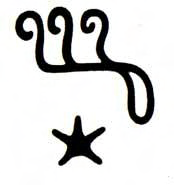
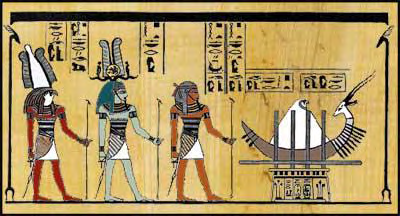
Concerning the general relationship between Orion, Sirius and the Egyptian deities, Egyptologist Dr.
Bojana Mojsov states:
The constellation of Orion was linked with Osiris: ―He has come as Orion. Osiris has come as
Orion,‖ proclaim the Pyramid Texts. Sirius and Orion, Isis and Osiris, inseparable in heaven as on
earth, heralded the inundation and the rebirth of life. Their appearance in the sky was a measure
of time and a portent of great magnitude. In historic times, both occasions were always marked
by celebrations.65
Ancient Egyptian hieroglyph for Orion,
with three-looped string and star
(Budge, Ancient Egyptian Hieroglyphic
Dictionary, 638)
The ―three kings‖ approaching the baby in a manger can also be seen in the ritual of the baby falcon god
Sokar, who was brought out of the temple at the winter solstice and who has been identified with Horus.66
The baby Sokar approached by Ptah-Sokar-Osiris at the winter solstice
(Wilkinson, Manner and Customs of the Ancient Egyptians, III, 18;
Murdock, The 2010 Astrotheology Calendar, 34)
15.
At the age of 12, he was a prodigal child teacher, and at the age of 30 he was
baptized by a figure known as Anup and thus began his ministry.
Child Teacher: Regarding Horus‘s role as a ―child teacher in the temple,‖ Murdock relates:
…In the first place, Horus was commonly viewed as the rising sun, during which time, it could be
said, ―He dwelt on earth as mortal Horus in the house of Seb (earth) until he was twelve years of
age.‖ In the solar mythos, the ―age‖ of 12 refers to the sun at high noon, the twelfth hour of the
day, when the ―God Sun‖ is doing his ―heavenly father‘s work‖ in the ―temple‖ or ―tabernacle‖ of
the ―most high.‖ In the Egyptian myth, the child Horus—the rising sun—becomes Re at the ―age‖
of 12 noon, when he moves into his ―Father‘s house,‖ in other words, that of Re and/or Osiris,
who are interchangeable, as we have seen. Indeed, while the sun gods or solar epithets are
interchangeable in and of themselves, in certain texts…Re is specifically named as Horus‘s
father; hence, the relationship here is doubly appropriate. The fact of Horus attaining so quickly to
such maturity certainly may impress his elders, the older suns, as he literally becomes them. To
64 Allen, J., 107.
65 Mojsov, 7.
66 For more information, see Murdock, CIE, 107ff.
put it another way, Horus is the sun from the time it arrives on the horizon until 12 noon, at which
point he becomes Re, the father of the gods and the ―father of Horus‖ as well. It could thus be
said that Horus does his father’s work in the temple at the age of 12.
In The Dawn of Astronomy, [Royal Astronomer Sir Norman] Lockyer describes this process of
Horus becoming Re at the hour or ―age‖ of 12:
We have the form of Harpocrates at its rising, the child sun-god being generally
represented by the figure of a hawk. When in human form, we notice the presence of a
side lock of hair. The god Ra symbolises, it is said, the sun in his noontide strength; while
for the time of sunset we have various names, chiefly Osiris, Tum, or Atmu, the dying sun
represented by a mummy and typifying old age. The hours of the day were also
personified, the twelve changes during the twelve hours being mythically connected with
the sun‘s daily movement across the sky.
The various ―phases‖ of the sun‘s journey were given different personalities, while remaining one
entity. Hence, Horus the Child wears the side lock until 12 noon when he becomes the adult Re.67
Murdock also says:
In the Egyptian story of Khamuas/Khamois found on Papyrus DCIV of the British Museum
appears an interesting tale about Sa-Asar, Si-Osiris or Senosiris—the ―son of Osiris‖—who ―grew
rapidly in wisdom and knowledge of magic.‖ The tale continues: ―When Si-Osiris was twelve
years old he was wiser than the wisest of the scribes.‖ This story includes fantastical elements—
such as a visit to the underworld—that indicate it is not historical but may well revolve around
Horus, son of Osiris. Thus, in Egypt we find a similar tale as in the gospel about the ―son of God‖
who is 12 years old and is precocious in intelligence and knowledge, besting the elders and
scribes.68
Baptism: Baptism in the ancient pre-Christian world, including in Egypt, was common, as related by early
Church father Tertullian (c. 160-c. 220):
For washing is the channel through which [the heathen] are initiated into some sacred rites—of
some notorious Isis or Mithras. The gods themselves likewise they honour by washings.69
In CIE, Murdock discusses the ancient Egyptian purification or baptism:
Concerning the sun god‘s nightly journey back to life, Egyptologist Dr. Jacobus Van Dijk of the
University of Groningen says that ―according to the Pyramid Texts, the sun god purifies himself in
the morning in the Lake of the Field of Rushes.‖ Thus, the morning sun—or Horus—was said to
pass through the purifying or baptismal waters to become reborn, revivified or resurrected.70
Murdock references several Pyramid Texts citing the issue of using a ―Divine Lake‖ to purify.
The Egyptian god Anpu, Anup or ―Anubis,‖ the latter of which is his Greek name, is the Egyptian
precedent for the Christian character John the Baptist. There are many similarities, such as Anubis being
the ―Preparer of the Way of the Other World‖71 and John the Baptist being ―preparer of the way of Christ.‖
As another, Anubis serves as ―purifier‖ or ―baptizer‖ of Egyptian gods and deceased persons, including
both Horus and Osiris.
Concerning the role of Anubis/Anup in Egyptian mythology, lay Egyptologist Gerald Massey states:
The karast is literally the god or person who has been mummified, embalmed, and anointed or
christified. Anup the baptizer and embalmer of the dead for the new life was the preparer of the
karast-mummy. As John the Baptist is the founder of the Christ in baptism, so Anup was the
christifier of the mortal Horus, he on whom the holy ghost descended as a bird when the Osiris
made his transformation in the marriage mystery of Tat tu (Rit., ch. 17). We read in the funeral
67 Murdock, CIE, 214.
68 Murdock, CIE, 213.
69 Tertullian, On Baptism, V , p. 9.
70 Murdock, CIE, 247.
71 Bonwick, 120.
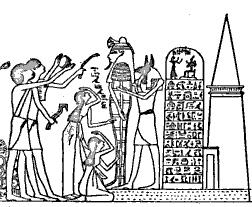
texts of Anup—being ―Suten tu hetep, Anup, neb tser khent neter ta krast-ef em set‖ (Birch,
Funereal Text, 4th Dynasty). ―Suten hept tu Anup tep-tuf khent neter ha am ut neb tser krast ef em
as-ef en kar neter em set Amenta‖ (Birch, Funereal Stele of Ra-Khepr-Ka, 12th Dynasty). Anup
gives embalmment, krast; he is lord over the place of embalmment, the kras; the lord of
embalming (krast), who, so to say, makes the ―krast.‖ The process of embalmment is to make the
mummy. This was a type of immortality or rising again. Osiris is krast, or embalmed and
mummified for the resurrection. Passage into life and light is made for the karast-dead through
the embalmment of the good Osiris (Rit., ch. 162)—that is, through his being karast as the
mummy type. Thus the Egyptian krast was the pre-Christian Christ, and the pictures in the
Roman Catacombs preserve the proof.72
For a detailed discussion of the term ―karast‖ or ―krst,‖ see Murdock, CIE, pp. 313-318.
Regarding Anubis‘s role as not only embalmer but also ―purifier,‖ Murdock remarks:
… as embalmer, Anubis‘s purifying role in mummification is made clear in the fact that he
presides over the ―House of Purification‖ and ―Tent of Purification,‖ the latter called tp-jbw in
Egyptian. In describing the funerary rituals, Dr. Lesko states:
Pouring of water, for its life-giving as well as purification qualities, was part of every ritual.
The corpse, whether first desiccated or not, would have been washed (in the Tent of
Purification) and then anointed and wrapped in the embalmer‘s shop. Seven sacred oils
used for anointing the body are known already in the first dynasty….73
There is much more to this subject, and interested parties are directed to the 28-page chapter ―Anup the
Baptizer‖ in Murdock‘s Christ in Egypt.
Anubis purifying the Osiris
(Renouf, Egyptian Book of the Dead, 51)
16.
Horus had 12 disciples he traveled about with, performing miracles such as
healing the sick and walking on water.
Again, these themes were not all rolled into one in this manner in an ancient text but are put together here
in order to reconstruct the Horus myth, the same as mythographers do with modern encyclopedia entries.
The motifs exist separately in a variety of texts, from which the creators of Christianity evidently drew for
their narrative.
12 Disciples: In Chaldean Magic: Its Origins and Development, French archaeologist Francois
Lenormant states:
72 Massey, AELW, I, 218. For a discussion of Massey‘s work, which was based on that of the best Egyptologists of
his day, some of whom also reviewed his writings prior to publication, see Christ in Egypt, pp. 13-23.
73 Murdock, CIE, 249.
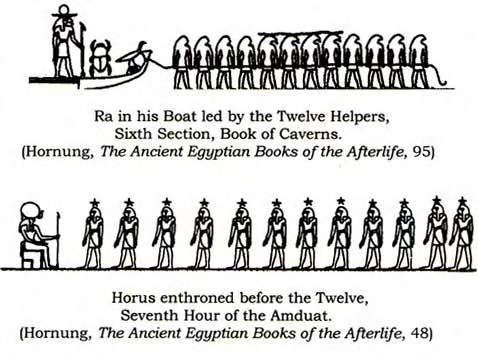

...The sun of the lower Hemispheres took more especially the name of Osiris. Its companions and
deputies were the twelve of the night personified as so many gods, at the head of which was
placed Horus, the rising sun itself...74
As Murdock says:
The configuration of Re, Osiris or Horus with 12 other individuals, whether gods or men, can be
found abundantly in Egyptian texts, essentially reflecting the sun god with 12 ―companions,‖
―helpers‖ or ―disciples.‖ This theme is repeated numerous times in the nightly passage of the sun:
Like Hercules in his 12 labors, when the Egyptian sun god entered into the night sky, he was
besieged with trials, as found in some of the Egyptian ―Holy Scriptures.‖ One such text is the
―Book of the Amtuat/Amduat,‖ which ―describes the journey of the sun god through the twelve
hours of the night,‖ the term ―Amduat‖ meaning ―underworld‖ or ―netherworld.‖...
Horus is thus firmly associated with 12 ―star-gods,‖ who, in conducting the sun god through his
passage, can be deemed his ―protectors,‖ ―assistants‖ or ―helpers,‖ etc.75
Concerning this motif of Horus and the Twelve, Murdock also states:
...in the tenth hour of the Amduat, Horus the Elder leaning on his staff is depicted as leading the
12 "drowned" or lost souls to their salvation in the "Fields of the Blessed." These 12 deceased,
Hornung relates, are "saved from decay and decomposition by Horus, who leads them to a
blessed posthumous existence..." In this manner, Horus's companions, like the disciples of Jesus,
are meant to "become like gods," so to speak, and to exist forever, reaping eternal life, as do
those who believe in Christ.76
Horus helps the 12 drowned souls ―find their way to the Fields of the Blessed,‖
commanding them as they are being ―deified‖
10th hour of the Amduat
Tomb of Amenophis/Amenhotep II (14th cent. BCE)
(Hornung, Valley of the Kings, 138, 144)
For much more on this subject, see Christ in Egypt, pp. 262-284.
74 Lenormant, 83.
75 Murdock, CIE, 269-271.
76 Murdock, CIE, 271.
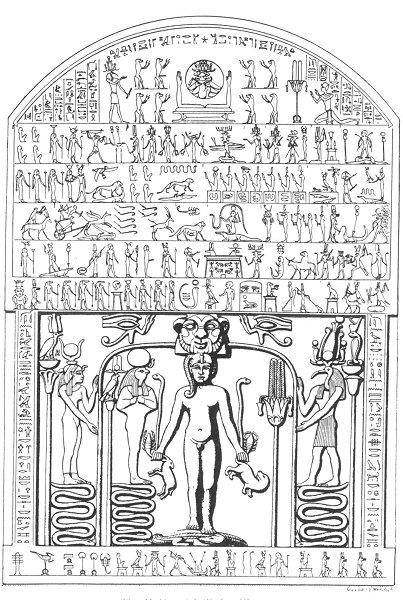
Miracles: As in many other religions, the Egyptian gods and goddesses were known to produce miracles,
including healing the sick, ―walking on water‖ and raising the dead. Regarding Horus being associated
with healing, Greek historian of the first century BCE Diodorus Siculus remarks:
They say Horus, in the Greek Tongue, is Apollo, who was taught both medicine and divination by
his mother Isis, and who showers benefits on the race of man through his oracles and his cures.77
Concerning the motif of the god ―commanding the waters,‖ Murdock relates:
In BD [Book of the Dead spell] 62…the deceased, who is Re or Osiris, pleads to have ―command
of the water,‖ saying, ―May I be granted power over the waters…‖
Spel s 57, 58 and 59 of the BD are titled chapters for ―command of water‖ or ―having power over
water,‖ while BD 57 includes the request:
Oh Hapi, Chief of the heaven! in thy name of Conductor of the Heaven, let the Osiris
prevail over the waters...78
Murdock also writes:
The command over water includes the crossing of the ―celestial river‖: ―Upon reaching the sky,
the life-essence of the King approaches the celestial gate and/or the celestial river.‖ When the
king reaches the river with his ―mentor‖ Horus, he requests the god to take him with him: ―Since
Horus has already crossed the river with his father in mythical times…, he can apparently then
cross the river at will.‖79
For much more on these subjects, see Christ in Egypt, pp. 285-308.
Horus the Child on the Metternich Stela
c. 380-342 BCE
(Metropolitan Museum of Art, NY)
―This stele represented the power to protect man
possessed by all the divine beings in the
universe, and, however it was placed, it formed
an impassable barrier to every spirit of evil and
to every venomous reptile.‖
(Budge, Legends of the Egyptian Gods, lxii)
77 Diodorus/Murphy, 31-32.
78 Murdock, CIE, 293.
79 Murdock, CIE, 296-297.
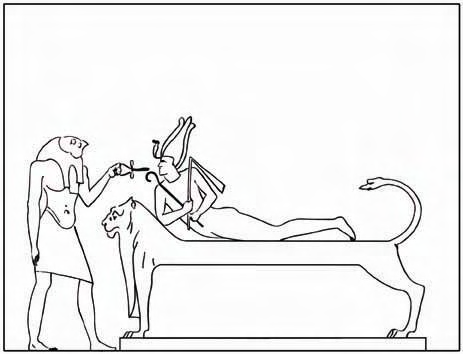
Horus resurrecting Osiris using the cross of eternal life
(Lundy, Monumental Christianity, 403)
17.
Horus was known by many gestural names such as The Truth, The Light, God’s
Anointed Son, The Good Shepherd, The Lamb of God, and many others.
Many Egyptian gods and goddesses held ―sacred titles‖ of one sort or another. For example, in
chapter/spell 125 of the Egyptian Book of the Dead, the deceased addresses Osiris as the ―Lord of
Truth,‖ and it is also easy to understand why solar gods would be deemed ―The Light.‖ Following is a
compilation of epithets taken from the Egyptian Book of the Dead, as applied to various deities, including
Osiris, Isis, Horus, Re, Anubis, Thoth and Seb:
Lord of Lords, King of Kings, Lord of Truth, Savior, the Divine, All-Powerful, the Unknowable,
Great God, Lord of All, Inviolate God, God of Justice, Lord of Justice, Lord of Right, Lord of
Prayer... Son of the Great One... Lord of Light... The Giver of Light, Lord of the Horizon, Lord of
Daylight, Lord of the Sunbeams, Soul of his father, Lord of Years, Lord of the Great Mansion...80
Concerning the Egyptian ―savior,‖ Murdock states:
…according to the hymns some 1,400 years before the purported advent of Christ, the sun is the
―unique shepherd, who protects his flock,‖ also serving as a ―savior.‖ In the Coffin Texts appears
another mention of the Egyptian god as ―savior,‖ as in CT Sp. 155, in which the speaker
specifically defines himself as a god and also says, ―Open to me, for I am a saviour…‖ In CT Sp.
847, the deceased—who at times is Osiris and/or Horus—is the ―Saviour-god.‖…81
Regarding Horus‘s other epithets, William R. Cooper relates:
The very first of the chief epithets applied to Horus in this, his third great office, has a startlingly
Christian sound; it is the ―Sole begotten son of the Father,‖ to which, in other texts, is added,
―Horus the Holy Child,‖ the ―Beloved son of his father.‖ The Lord of Life, the Giver of Life [are
also] both very usual epithets...the ―Justifier of the Righteous,‖ the ―Eternal King‖ and the ―Word of
the Father Osiris.‖…
...very many of the essential names and attributes of Horus were attributed to Ra, Tum, and the
other deities also, they were alike ―self-created,‖ ―born of a Virgin,‖ ―deliverers of mankind,‖ ―only
begotten sons‖...82
The epithet of ―God’s Anointed Son‖ is a combination of Horus being called ―Anointed‖ and ―Beloved
son‖ of his father, Osiris, this latter epithet being very common in the Pyramid Texts.83 As an example of
Horus‘s anointed or christed state, Pyramid text W 51/PT 77:52a-b says:
80 See Murdock, CIE, 329-320.
81 Murdock, CIE, 310.
82 Cooper, 22, 76-77.
Ointment, ointment, where should you be? You on Horus‘s forehead, where should you be? You
were on Horus‘s forehead...84
Concerning the god as ―Good Shepherd,‖ Murdock also remarks:
In BD [Book of the Dead spell] 142 appears a long ―List of the Forms and Shrines of Osiris,‖ with
over 140 epithets for the god, including the ―Protector‖ or ―Shepherd‖—A











